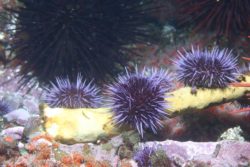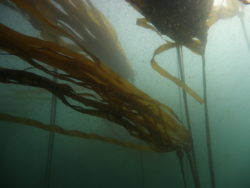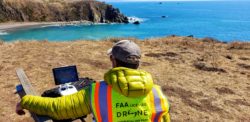
Kelp Forest Restoration & Recovery in the Greater Farallones National Marine Sanctuary
By Rietta Hohman, Greater Farallones Association, NOAA Affiliate Coordinator of the Greater Farallones Kelp Recovery Program

Fort Ross Coastline, Greater Farallones National Marine Sanctuary. Photo: Abby Nickels/Greater Farallones Association
Along coastlines around the globe where cold, nutrient-rich water moves up to the surface from the deep, lush forests of kelp thrive. Kelp forests are similar to forests on land – they have layers, including a canopy and understory, and they rely on nutrients and sunlight to grow and reproduce. Mostly hidden from view, kelp forests are teeming with life just beneath the surface of the ocean. These underwater forests not only provide habitat for myriad fish, invertebrates, marine mammals, and more, they also provide critical services to people — termed ecosystem services — including the ability to take up and store carbon, reduce the impact of ocean acidification, and dampen wave energy to reduce coastal erosion (just to name a few!). They are also intricately tied to the well-being of nearshore ecosystems and coastal communities, not to mention they are amazing to explore when freediving or on SCUBA for those armed with a thick wetsuit and the courage to face chilly waters.

Purple urchins in Greater Farallones National Marine Sanctuary. Photo: Steve Lonhart
Unfortunately, this once-vibrant ecosystem has all but disappeared in northern California. Over a short period of time, a combination of ecological stressors suppressed kelp growth and fostered a population boom in urchins, resulting in an estimated loss of over 90% of kelp forest canopy in this region (Rogers-Bennet and Catton 2019) and drone surveys in 2019 and 2020 indicate there has been no significant recovery. As a volunteer research diver on the north coast, I witnessed this dramatic loss of kelp firsthand in 2014. It was like a switch had been flipped. Sites that I had been diving for years suddenly shifted from a beautiful and vibrant kelp forest, to a field of endless urchins. The nearshore ecosystem had reached an ecological threshold, with the combination of several key stressors triggering a rapid shift in the community of organisms. A multi-year marine heatwave created unfavorable conditions, including warm ocean temperatures and low nutrients for kelp growth and productivity, while urchin populations had high growth and low rates of mortality from the absence of predators, disease and starvation (McPherson et al. 2021). Now, along over a hundred miles of the coastline, kelp forests have largely been replaced by urchin barrens — areas with lots of urchins (up to 60 times as many!) and little of anything else (no kelp means no fish, invertebrates or mammals), and as a result, little to no primary productivity. The urchins chow down on everything in their path, so kelp forest ecosystem recovery is an uphill battle. An urchin barren is considered an alternative stable state to a kelp forest, and in some areas around the world they have been observed to last for decades. And due to the lack of structured habitat and an absence of food, urchin barrens can’t support healthy populations of fish or invertebrates, so we see devastating ecological and economic consequences. Though some kelp forests eventually recover, the scale of loss along northern California indicates that, without restoration efforts, these urchin barrens may be around for a very long time.
Tackling kelp forest restoration along hundreds of miles of coastline is a daunting task. But with strong partnerships, Greater Farallones Association and Greater Farallones National Marine Sanctuary are taking critical steps forward. We work with a passionate community of individuals, organizations, Tribes, and agencies who have taken an active role to collaborate and seek solutions for broad-scale restoration and recovery of kelp forests in the Greater Farallones National Marine Sanctuary. In 2018, the Greater Farallones Sanctuary Advisory Council initiated a Kelp Recovery Working Group to develop solutions to address severe kelp loss on the north coast. From these recommendations, the Greater Farallones Association developed the Sonoma-Mendocino Kelp Recovery Plan, a guidance document for the Sanctuary and the California Department of Fish and Wildlife which outlines strategies for kelp restoration, monitoring, research and community engagement.
The Farallones Kelp Recovery Program, a joint program of the Greater Farallones Association and Greater Farallones National Marine Sanctuary, is now actively implementing these strategies, and we have already made great strides towards fostering kelp recovery. With the support of the National Marine Sanctuary Foundation, and through an incredible collaboration with The Nature Conservancy and numerous academic partners, we initiated one of the largest marine mapping projects using drones to ever take place in California. This is the first assessment of regional kelp beds since 2016 and data will be critical for strengthening kelp management and restoration efforts.

Bull kelp, an annual seaweed that grows from a spore to maturity within one year. Photo: California Department of Fish & Wildlife.
We are pursuing innovative ways to restore kelp forests in the sanctuary. We know that the primary obstacle to kelp recovery is grazing pressure from urchins. To address this issue, we have teamed up with California commercial urchin divers who have the knowledge, expertise, and equipment to conduct large-scale urchin removals. These divers have been doing restoration on a small scale for years, through collaboration with Reef Check California, the Noyo Center for Marine Science, and the Waterman’s Alliance. Reducing urchin populations will ease grazing pressure to allow kelp growth. Through a collaboration with Moss Landing Marine Laboratories, we will “plant” individual baby kelps to jump-start recovery of the population in the spaces cleared of urchins. By targeting key recovery sites for restoration, we aim to establish a network of healthy kelp oases along the coast to act as source populations for surrounding areas, ultimately supporting coast-wide recovery and increasing ecosystem-wide resilience to changing ocean conditions.
It is important to keep in mind that urchins are not the villains, they are just really good at surviving. A native species, urchins play an important role in healthy kelp forests. Urchins are grazers and kelp is the buffet; the less food that is available, the more aggressively urchins graze – especially when starved. Right now, our nearshore ecosystem is out of balance, and we must lend a kelping hand to tip the favor back in the direction of kelp forests.
I’ve dedicated much of the last ten years of my personal and professional life to kelp forests – the first five by studying them as a research diver, the last five by developing and implementing restoration strategies to try and bring them back from the brink of collapse. Through the work that we and our partners have accomplished, I have more hope now than ever that someday soon we will see healthy kelp forests on California’s north coast again.
To learn more, and find out how you can help, visit Farallones.org/climate/kelp.

Kelp assessment project underway at Fort Ross, Greater Farallones National Marine Sanctuary. Photo: Abby Nickels/Greater Farallones Association
